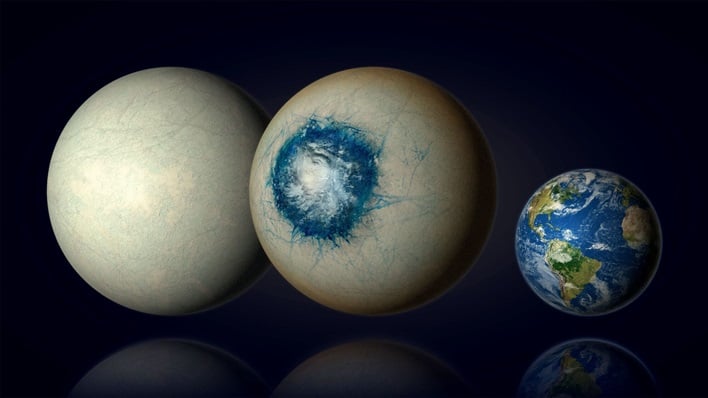
Astronomers using data collected by NASA’s James Webb Space Telescope have identified an exoplanet as a “promising super-Earth” and unlike the one JWST spotted earlier this year, it looks like a giant eyeball peering into the Universe. Exoplanet LHS-1140b shows signs of having a global ocean covered in ice, with an area of about 2,500 miles, the iris-like region, permanently staring at its host star.
The planet is about 48 light-years from Earth in the constellation Cetus, and might have an atmosphere and possibly a liquid water ocean, making it one of the most promising habitable zone exoplanet candidates known. The new study, led by the University of Montreal, used data collected from NASA’s Webb telescope in December 2023, as well as previous data from other space telescopes such as Spitzer, Hubble, and TESS to come to their conclusions.
“This is the first time we have ever seen a hint of an atmosphere on a habitable zone rocky or ice-rich exoplanet,” explained Ryan MacDonald, NASA Sagan Fellow in the University of Michigan’s Department of Astronomy. “LHS-1140b is one of the best exoplanets in the habitable zone capable of supporting a thick atmosphere, and we might just have found evidence of air on this world.”

Exoplanet LHS-1140b orbits a low-mass red dwarf star about one-fifth the size of Earth’s Sun. First discovered in 2017, it captured the attention of scientists and astronomers because of it being one of the closest exoplanets to the solar system, and it being within its star’s “Goldilocks Zone,” or habitable zone. Being in the habitable zone, it could have temperatures that would allow water to exist in liquid form, a critical element for life.
“Of all currently known temperate exoplanets, LHS 1140 b could well be our best bet to one day indirectly confirm liquid water on the surface of an alien world beyond our solar system,” explained Charles Cadieux, lead author of the science paper and doctoral student at University of Montreal. “This would be a major milestone in the search for potentially habitable exoplanets.”
MacDonald says that compared to other known habitable zone exoplanets, the star LHS-1140b orbits is “much calmer and less active” than others being studied currently. This makes separating the exoplanet’s atmosphere from stellar signals caused by starspots.
The astronomers plan to use future Webb observations to confirm LHS-1140b has a nitrogen-rich atmosphere, as well as search for other gases. According to MacDonald, “This is a very promising start.”